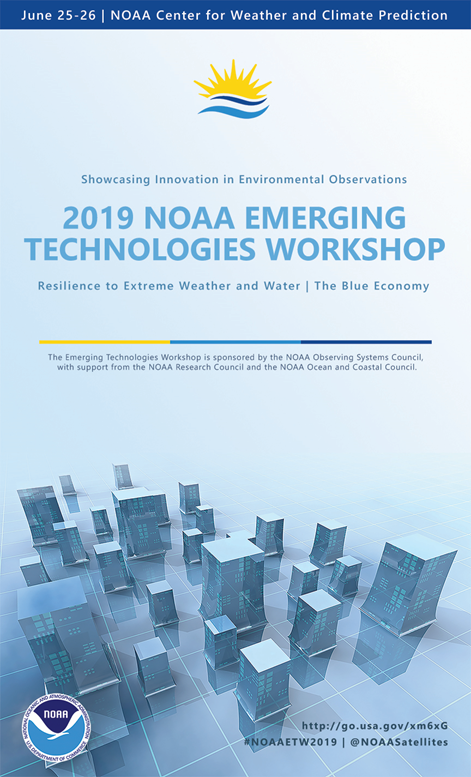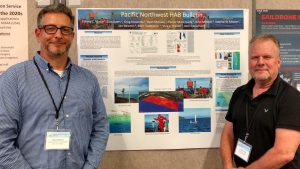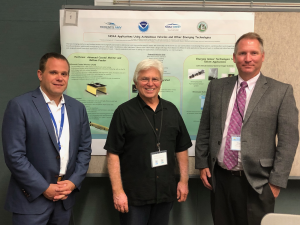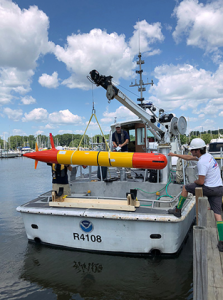
At the Third NOAA Emerging Technologies Workshop, NCCOS’ contributions to observation research and technology development were on display. NCCOS scientists gave two oral presentations, showcased two posters, and participated in a special emerging technologies discussion panel.
Here is information about NCCOS contributions to observation technology presented at the workshop.
Mobile, In-situ HAB Toxin Warning and Genomic Observation for the Great Lakes Oral presentation by Greg Doucette (NCCOS/Stressor Detection & Impacts), with co-authors Steve Ruburg (NOAA Great Lakes Environmental Research Laboratory/GLERL) and Kelly Goodwin (NOAA Atlantic Oceanographic & Meteorological Laboratory). Operated by NOAA GLERL and partners at the Monterey Bay Aquarium Research Institute, the world’s first mobile, autonomous, freshwater Environmental Sample Processor (ESP) tracks and reports levels of toxins produced by cyanobacterial blooms. This third-generation ESP uses miniature sensor chip technology (ELISA method) developed by NCCOS to measure microcystin concentrations. Samples are also archived on the ESP for post-deployment ‘omics analysis of toxin genes and community structure.
Bathy Mapping with UAS and Motion Software. Oral presentation by Tim Battista (NCCOS/Marine Spatial Ecology). Unmanned Aerial Systems (UAS), aka drones, acquire video and photographs to map land elevations and water depths. The depth soundings collected by the water surface drones are used to validate the depths derived from the digital aerial photos taken by the airborne drones. These platforms, combined with Structure from Motion (SfM) software, are capable of producing centimeter-scale photo mosaics, elevation, and depth data for nearshore environments.
Pacific Northwest Harmful Algal Bloom Bulletin. Poster by Tiffany Vance (NOAA Integrated Ocean Observing Sysyem) with co-authors including Greg Doucette (NCCOS/SDI) and Marc Suddleson (NCCOS/Competitive Research Program). The Pacific Northwest HAB Forecast system assembles data from offshore and beachside monitoring of ocean conditions and algal and toxin concentrations to predict HAB outbreaks to support management of shellfisheries, clamming beaches, and human health. The data and forecast are incorporated into a PNW HAB Forecast Bulletin.
NOAA Applications Using Autonomous Vehicles and Other Emerging Technologies. Poster by Robert Warner (NCCOS/SDI), with co-authors colleagues from University of Puerto Rico Mayaguez (UPRM) and Tridentis Advanced Marine Vehicles (AMV). NCCOS Stessor Detection & Impacts Division/Monitoring & Assessment Branch (SDI/MAB) conceived platforms, consulted with NOAA line offices for example applications and submitted subtopics for NOAA Small Business Innovation Research Program (SBIR) in 2017 (for a mobile coastal monitor) and 2018 (for subsurface platform). The recipient of SDI/MAB SBIRs were awarded to Tridentis LLC and Tridentis AMV to develop a (1) modular autonomous surface vessel, the Advanced Coastal Monitor (ACM), with sophisticated collision avoidance incorporating “rules of the road” and many features to support NOAA’s mission, and (2) a modular, highly maneuverable, Autonomous Underwater Vehicle, with the ability to operate at higher survey speeds and also transition while underwater to a Remotely Operated Vehicle, to “feed benthic data to the surface” – named Bottom Feeder, to support NOAA underwater applications. To demonstrate the ease of incorporating applications onto Tridentis vehicles, UPRM student projects were presented.
Advanced Coastal Monitor: Autonomy and Modularity in Marine Survey Vehicles. Oral presentation by William Latham (Tridentis AMV) with co-authors David Jochum (Tridentis LLC) and Robert Warner (NCCOS/SDI/MAB). William Latham described SDI/MAB marine vessel concepts and how Tridentis used “clean sheet” approach to incorporate concepts as well as NOAA line office examples into Tridentis’ Advanced Coastal Monitor and Bottom Feeder, which compliments current AUVs operating for NOAA.
Emerging Technologies Discussion Panel. NCCOS Director Dr. Steven Thur participated on a panel discussing new observational technologies in relation to NOAA research and development, and addressing challenges associated with transition to operations. In addition to Dr. Thur, panelists included Cisco Werner (Chair/NMFS), Hendrik Tolman, (NWS), John Cortinas (OAR), Bill Michaels (NMFS), Harry Cikanek (NESDIS), Gary Matlock (OAR).



